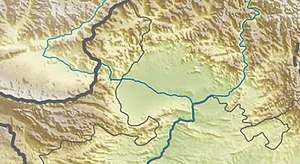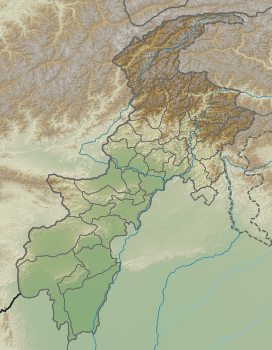Barikot
Barikot (Urdu: بریکوٹ), the ancient Bazira of Alexander the Great,[2] with Chalcolithic remains since c. 1700 BC,[3] and an Early Historic period town since c. 500 BC.[4] Barikot is a city located in the middle course of Swat River in the Khyber Pakhtunkhwa Province of Pakistan. It is about 20 km (12 mi) away from Mingora and from Butkara.[5] It is the entrance town to middle Swat valley with a population of 25,000 approximately. The Italian Archaeological Mission (renamed ISMEO), founded by Giuseppe Tucci has been excavating ruins of the ancient town of Bazira under Barikot since 1984.[6]
Barikot بریکوٹ | |
|---|---|
 Barikot  Barikot  Barikot | |
| Coordinates: | |
| Country | Pakistan |
| Province | Khyber-Pakhtunkhwa |
| District | Swat District |
| Elevation | 808 m (2,651 ft) |
| Population | |
| • Total | 184,000 |
| Time zone | UTC+5 (PST) |
Excavations
The expeditions in the 1980s and 90s discovered an Indo-Greek town from around the time of King Menander I in the 2nd century BC. The 2nd century BC town covered, at its peak, an area of about 12 ha (30 acres) including the acropolis, or about 7 ha (17 acres) without. It was surrounded by a defensive wall with massive rectangular bastions.[7] Beginning in 2011, an excavation in the south west corner of the site discovered several older settlements. One pre-Indo-Greek level was dated to the mid 3rd century BC or in the middle of the Mauryan era.[8] It was thought the oldest layer under Barikot was a village which has been dated to 1100-1000 BC,[6] but previous Chalcolithic pit strucures are attested since 1700 BCE.[9]
Early Iron Age proto-urban layers were found, and dated to eleventh-eight centuries BCE, archaeologists also found that the fortified urban settlement in Barikot (lower area and acropolis) was established around mid-first millennium BCE.[10]
The excavations have discovered a number of artifacts which document the daily life of the residents, including coins, pottery and weapons. Several large artifacts including, a large green-schist statue of Siddhartha Buddha riding his horse Kanthaka and a carving of a stupa with two lions, document the Buddhist history of Bazira. Another statue depicting an unknown deity sitting on a throne, with long, curled hair, holding a wine goblet and a severed goat head in his hands may represent Dionysus, the Greek god of wine or another local deity.[11]
Kushan Times
Under the Kushan Empire it grew into a major town before a series of earthquakes in the 3rd century AD devastated it. Probably due to the damage from the earthquakes as well as the decline of the Kushan Empire, Bazira was abandoned by the end of the 3rd century.[11]
 Barikot ruins panorama.
Barikot ruins panorama.- City of Barikot in the foreground, and the remains of the Bazira fortress are on top of the Ghundai Hill.
 Bazira fort with remaining fortifications
Bazira fort with remaining fortifications- Barikot Artifact.
- Ruins.
Turk Shahi Times
Turk Shahi was a Kabul-based Turkic dynasty which also ruled Swat Valley (from 7th to 9th centuries CE), so members of the Italian Archaeological Mission in Pakistan were able to find a unique temple from this period, built in Barikot, on the top of Ghwandai mound. It's an important discovery as there are few cultic centres in this region belonging to Shahi periods in general. Dr. Luca Maria Olivieri said the temple was built around 700 AD., by that time Uddiyana (Swat Valley) was ruled by a king known as "From Kesar", who was the son of Tegin Shah Khurasan, a well-known Turk Shahi king from Kabul, and that the temple was re-established and maintained till the Hindu Shahi time (ca 1000 AD). The temple is also mentioned in a Hindu Shahi inscription, found in Barikot in the late 19th century and conserved in Lahore Museum.[12]
References
- "POPULATION AND HOUSEHOLD DETAIL FROM BLOCK TO DISTRICT LEVEL: KHYBER PAKHTUNKHWA" (PDF). Pakistan Bureau of Statistics. 2018-01-03. Archived from the original (PDF) on 2018-04-17. Retrieved 2018-04-23.
- Archaeological site notice
- Olivieri, Luca M., 2012. "When and why the ancient town of Barikot was abandoned?: A preliminary note based on the last archaeological data", in Pakistan Heritage 4, Table 1, and p. 111.
- Olivieri, Luca Maria, & Anna Filigenzi, 2018."On Gandharan sculptural production from Swat: Recent archaeological and chronological data", in W. Rienjang and P. Stewart (eds.), Problems of Chronology in Gandharan Art: Proceedings of the First International Workshop of the Gandhara Connections Project, p. 71.
- Road sign
- "Pakistan unearths the city defeated by Alexander the Great". AGI - Agenzia Giornalistica Italia (in Italian). 16 August 2016. Retrieved 13 September 2017.
- Khaliq, Fazal (24 May 2015). "Swat's archaeological sites: a victim of neglect". DAWN.COM. Retrieved 2017-09-13.
- Khaliq, Fazal (26 June 2016). "Archaeologists discover layers of Indo-Greek city in Swat". DAWN.COM. Retrieved 13 September 2017.
- Olivieri, Luca M., 2012. "When and why the ancient town of Barikot was abandoned?: A preliminary note based on the last archaeological data", in Pakistan Heritage 4, Table 1, and p. 111.
- Olivieri, Luca Maria, & Anna Filigenzi, 2018."On Gandharan sculptural production from Swat: Recent archaeological and chronological data", in W. Rienjang and P. Stewart (eds.), Problems of Chronology in Gandharan Art: Proceedings of the First International Workshop of the Gandhara Connections Project, p. 71.
- Jarus, Owen (29 April 2016). "Buddhist Sculptures Discovered in Ruins of Ancient Shrine". Live Science. Retrieved 13 September 2017.
- Discovery of Turki Shahi temple in Swat attracts archaeologists, Dawn, October 14, 2019
External links
| Wikimedia Commons has media related to Barikot Ghundai, Swat. |
- Report of the Italian Archaeological Mission (Pdf, Italian)